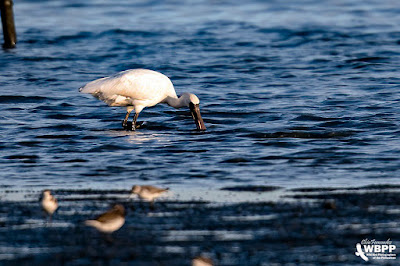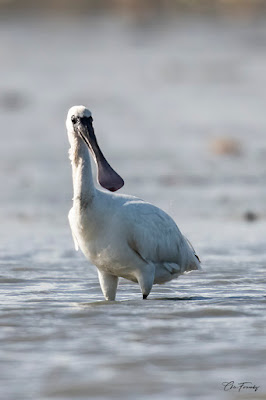Sometime in September, the WBPP Board had a zoom meeting with the top brass of DENR-NCR which resulted in a MOA wherein WBPP Org members will have access to DENR-NCR managed sites. In return, WBPP will help document the birds in these areas, get invited to join bird censuses, provide images to DENR if needed, etc.
Ed Santos, a member of the WBPP Board and its Treasurer, immediately made arrangements to visit the Tanza Marine Tree Park, located at Isla Pulo, Bgy Tanza, Navotas.
Pulo Island, commonly known as Isla Pulo, is a long, narrow island surrounded by mudflats in the Manila Bay coast of Navotas, about 13 kilometres (8.1 mi) north of Manila in the Philippines. It is a sitio in the northern village of Tanza, connected to the mainland of Navotas by a 500-meter long bamboo bridge.[1] The island is known for its mangroves for which it was declared a "marine tree park" and as one of four ecotourism sites in Metro Manila established under the National Ecotourism Strategy in 1999.[2][3] In 2014, it was home to a resettlement site of about 137 indigent families that mostly occupied the island's southern tip.[1]
The island's name is tautological toponym, for "pulo" already means "island" in the Filipino language. (wikipedia)
The first date set sometime in mid October (if my memory is accurate), but it was moved to October 23 due to a Typhoon. I was supposed to go with them but it coincided with the 40th day death anniversary of my mother-in-law. The party consisted of Ed, Win Paler and Homer Pialda. Ed's main goal was to be able to photograph the Chinese Egret, a rare migrant to the Philippines. But they were overwhelmed with the bird population of the area - Chinese Egret, Pied Avocet, Eurasian Curlew, Narcissus Flycatcher, Egrets, Plovers, and a host of other waterbirds. As is the case with NCR birding sites (or those nearby), other birders soon came, first in trickles, then in droves. The discovery of a Black-faced Spoonbill, an even rarer migrant and an endangered species, made sure of that.
I was supposed to go on October 26th but my mother got admitted to the hospital on the night of the 25th. Then this trip was moved to October 29th due to Typhoon Quinta. Still I was not able to go because we were still in the hospital (hirap maging solong anak 😀). My mother was finally discharged October 30, so with Typhoon Rolly fast approaching, I made sure I went to Navotas on October 31st. Obviously, the site had already caught the attention of the Manila birding community. I went with Homer Pialda (who had two other companions). When we arrived a little after 6am we found Loel Lamela, Ven Rojas, and Dick Tan already at the Boardwalk, with cameras mounted on tripods. A few minutes later, Adrian and Trinket Constantino arrived, followed by Prof Allan Fernando (we were in the same group in Ursula and Tubbataha), and other birders from both WBCP and WBPP. Hi's, hello's and nods of acknowledgement and a few fist bumps were exchanged as everyone set up their gear,
Then someone blurted Spoonbill and cameras, bins, and scopes were all trained on said bird. But it was too far for our cameras to get a good shot (well, maybe not for Loel's set up). Shortly thereafter, the photographers went down from the Boardwalk. I was fumbling with a spotting scope that attaches to a DSLR but being unfamiliar with it, I could not seem to get it to work so I returned it to my car and grabbed my regular gear and went down the mudflat. DENR's Mat Genson accompanied me to where the group was standing because the mud can be slippery. In my haste and excitement, I left my phone, water and reading glasses in the car (haaay....). But with the target bird in front of us, I just commenced firing. Sharing the initial images of the birds as well as the birders (photos of hoomans courtesy of Ven Rojas, Homer Pialda, Caloy Pangilinan and Harry Miller).
Black-faced Spoonbill with some plovers in the foreground
Black-faced Spoonbill with an egret
Blacl-faced Spoonbill
Black-faced Spoonbill
Marsh Sandpipers
Black-headed Gull
Chinese Egret (L); Little Egret (R)
After more than two hours at this spot, we decided to take a ride on a flat-bottomed, motorless banca, which will be propelled by its owner, (a fisherman), using a combination of footpower and paddle.
Gondola, Navotas style
Being in the water brought us closer to the birds who did not seem to be bothered by it. Probably because the boats are a regular part of the environment. And since one is much lower, the shooting angle is also much better. Early in our boat ride, we met the star of the day.
Black-faced Spoonbill
A bunch of Terns
Whiskered Tern
During our boat ride, we chatted with Meme, our boatman, who said that there used to be more birds but people would shoot them for food and sport. But this practice has stopped ever since DENR put a project in the area. Apparently, they apprehend offenders. Bravo!
After a little over an hour we were back at Terra Firma...
The Navotas Gondola Riders
At this point majority of the birders started going home. I was pleasantly surprised to see Caloy Pangilinan. We were shooting a few meters from each other in the mudflats but because of our face masks, we did not recognize each other. He was with Harry Miller who was with us at Epic Parc.
Caloy, Harry, Loel and myself
By 10:30am, only Loel, Dick, Prof Ferdie, myself and some WBCP birders on the mudflats were left. Loel and Dick decided to go for lunch. Prof Ferdie and I decided to go to another part of the mudflats. We were joined by three WBCP birders, all UP faculty. One of them turned out to be Jelaine Gan, a friend through FB.
The mudflats at this area were deceptive. A dry and firm looking soil is soft and hollow underneath. Prof Ferdie, who went ahead of me fell into a sink hole and had to be pulled out by the kids who were hanging around with us.
Once we reached safe ground we started looking for the Avocets but the birds were too far for my camera and even my bins. Jelaine generously let me look through her scope. I noticed two lady birders on a banca near the birds and made a sudden decision to go back again. I asked two of the boys to look for a banca for me and before long I was on my second boat ride. My main target was to get better photos of the Spoonbill, the Pied Avocets, and perhaps the Eurasian Curlew and the Bar-tailed Godwit. The Avocet and the Curlew would be lifers.
Before boarding the boat my two feet sank in the mud and I had a hard time getting them out. And for whatever reason, the boatman had a harder time pushing the banca out of the mudflats. It must have taken us 20-25 minutes to get to the sea. I was already second-guessing my decision to take another boat ride. Times like this, I also ask myself why I leave my comfy bed at dawn and walk in the mud. Fortunately, we finally got out of the mudflat and into the shallow sea part. And soon all doubts melted away...
Great Egret
Black-faced Spoonbill
Little Egret
After some time, we were on the other side of a sandbar. Hundreds, maybe thousands, of birds were scattered in front of us. I was staring at them, mesmerized and taking in the moment. Nino, my boatman, said "ser, baka nandiyan na ang hinahanap ninyo". This prompted me to use my bins to scan the shore. True enough, they were there... Preparen, Apunten, Fuego!
Pied Avocets, a lifer!
And there was an unexpected lifer!
Caspian Tern
I wanted to stay and look for the Curlew and Godwit but the wind picked up and the sea became "rougher". Nothing compared to the waves one experiences in Coron but given that I was in a motorless banca without katig (outriggers), and with my camera gear, I felt that the prudent thing was to head back. We saw Prof Ferdie, (who also took a second boat ride), and his boatman waving frantically at us. It turned out that they were stuck in the mud and was calling for help. But, Nino, my boatman said that if we rescue them, we might both get stuck. So he brought me to shore first.
The kids were waiting for us. They helped me out of the banca (my legs had turned numb!), got my gear, and escorted me back to the car. I found out that two of them were Grade 7 and one was Grade 8. We talked about their school work, they said they finished their modules for the day. And that the money I gave them earlier for washing my muddy feet, they gave to their mothers. Back at my car, I paid Nino, and let the kids again pour water on my mud covered feet. Then I tipped them for their "services" and gave them my remaining snacks and softdrinks. Afterwhich, I sat inside my car to rest a bit and review my shots. And all questions about birding were quickly forgotten.
Postscript. I was happy to have seen several WBPP friends, most of whom I have not seen in months. I was equally happy to have seen friends from WBCP - Prof Allan Fernando, Adrian and Trinket, Jelaine.
I would also like to acknowledge and thank the WBPP Board of Trustees for having this MOA with DENR and BIG SPECIAL THANKS to my good friend ED SANTOS, my favorite Letranista (di ko akalain na magkakaroon ako ng kaibigang Ariba), for his pioneering efforts to bird in Isla Pulo and the Navotas Mudflats. Because of this, other birders have a new site to visit. Thank you!
Keep safe everyone...




































